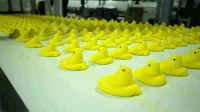Is your chocolate Easter egg bad
for the environment?
University of Manchester

With Easter fast approaching, the
thought of chocolate is probably on all our minds, but could the UK's love of
chocolate be having a damaging effect on the environment?
A recent study by researchers at The
University of Manchester and published in the journal Food Research
International has looked at the carbon footprint of chocolate and its
other environmental impacts.
It has done this by assessing the impacts of ingredients, manufacturing processes, packaging and waste.
It has done this by assessing the impacts of ingredients, manufacturing processes, packaging and waste.
The study estimates that the UK
chocolate industry produces about 2.1m tonnes of greenhouse gases (GHG) a year.
This is equivalent to the annual emissions of the whole population of a city as large as Belfast. It also found that it takes around 1000 litres of water to produce just one chocolate bar.
This is equivalent to the annual emissions of the whole population of a city as large as Belfast. It also found that it takes around 1000 litres of water to produce just one chocolate bar.
Chocolate is the UK's favourite
confectionary product, with the nation preferring milk over dark chocolate.
The industry was worth around £4 billion in the UK in 2014 and is set to grow by a further 9 percent by 2019.
On a global scale, the UK is the sixth highest chocolate-consuming country in the world. On average each person individually gets through approximately 8 kg per year, which is equivalent to around 157 Mars bars.
The industry was worth around £4 billion in the UK in 2014 and is set to grow by a further 9 percent by 2019.
On a global scale, the UK is the sixth highest chocolate-consuming country in the world. On average each person individually gets through approximately 8 kg per year, which is equivalent to around 157 Mars bars.
The study focused on the three most
popular types of chocolate products in the UK, which occupy 90% of the UK
market.
These are milk chocolate bars, sharing bags and snack chocolates. The team found the worst for the environment were the sharing bags due to their ingredients and bigger packaging.
These are milk chocolate bars, sharing bags and snack chocolates. The team found the worst for the environment were the sharing bags due to their ingredients and bigger packaging.
The researchers found the raw
materials used to produce chocolate are the major environmental hotspot as well
as the packaging. The impacts from the ingredients are mainly due to milk
powder, cocoa derivatives, sugar and palm oil.
Professor Adisa Azapagic, Head of
Sustainable Industrial Systems at the University, says: "Most of us love
chocolate, but don't often think of what it takes to get from cocoa beans to
the chocolate products we buy in the shop.
"Cocoa is cultivated around the
equator in humid climate conditions, mainly in West Africa and Central and
South America so it has to travel some distance before it makes it into the
chocolate products we produce and consume in the UK."
According to the International Cocoa
Organization the annual production of cocoa beans in 2016 was 4.25 million tonnes.
The worldwide sales of chocolate are estimated to be worth more than US$101
billion, with Europe accounting for 45% of the global consumption.
However, it's not only the cocoa --
it's also the milk powder used to make milk chocolates. Its production is very
energy intensive, plus dairy cows produce significant GHG emissions per litre
of milk produced. This all adds to the environmental impacts of chocolate.
Professor Azapagic added: 'It is
true that our love of chocolate has environmental consequences for the planet.
But let's be clear, we aren't saying people should stop eating it.
"The point of this study is to
raise consumers' awareness and enable more informed choices. Also, we hope this
work will help the chocolates industry to target the environmental hotspots in
the supply chains and make chocolate products as sustainable as possible."